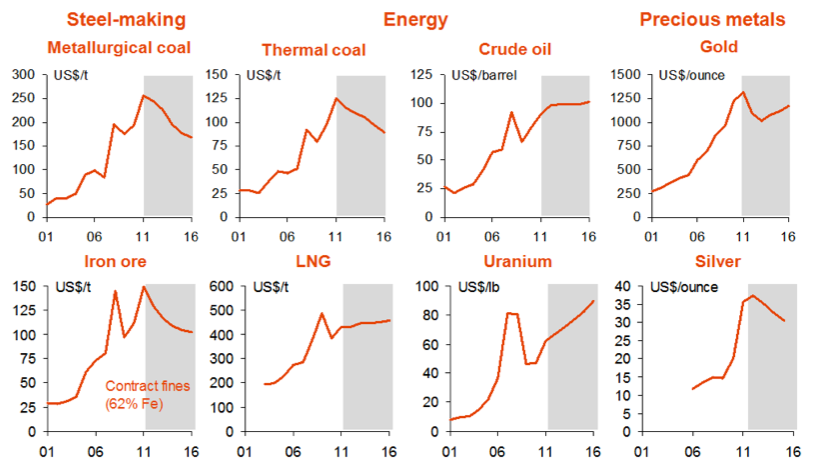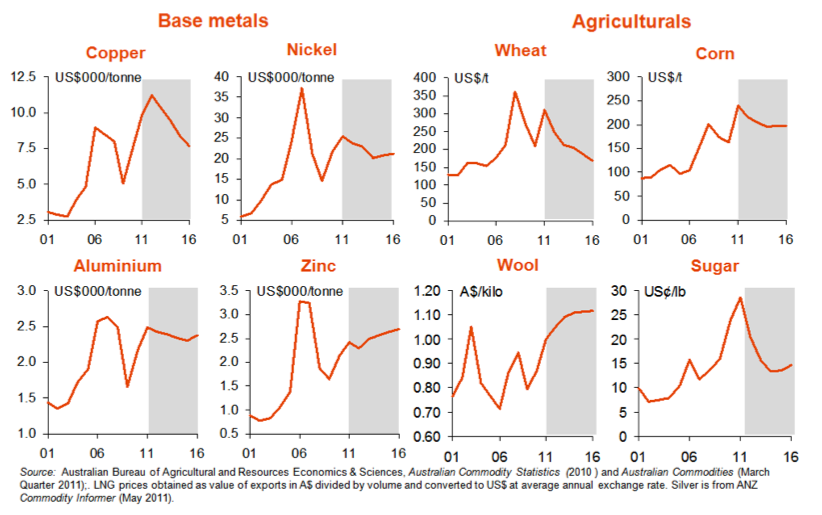Saul Eslake, Director of Productivity Growth Program at the Grattan Institute, yesterday presented a paper at the International Conference of Commercial Bank Economists in Amsterdam, the Netherlands, on some of the longer term demand and supply factors shaping the behaviour of commodity prices, over the past decade and over the next 5-15 years.
The full paper is below and as always from Saul the research is excellent and a recommended read.
The principal arguments of the paper are:
- first, that the steady rise in commodity prices since the early 2000s is largely the result of strongly rising commodity demand, especially from the world’s two most populous nations, which are now passing through a stage of economic development in which, if history is any guide, the ‘commodity intensity’ of economic growth increases significantly;
- second, that this stage of development probably has at least another decade to run in China and at least another two decades in India;
- third, that a range of constraints on commodity supply, including changes in the cost structure and composition of the mining industry, the depletion of the more easily obtainable supplies of minerals and energy, declining productivity in agriculture, and (possibly) the impact of climate change, have meant that supply has been much slower to respond to this increase in demand than in previous cycles; and
- fourth, that while the increasing ‘financialization’ of commodities markets over the past decade has almost certainly had the effect of amplifying the impact of these developments on prices, it has not caused them to run in a different direction than they would likely have done otherwise.
The paper contains some interesting conclusions and data about commodities futures.
To the extent that ecological factors may at some point inhibit the capacity of the Earth’s resources to support the convergence of living standards and consumption patterns in China and India to those of more advanced economies (something which this paper has not considered), commodity prices are likely to be higher, rather than lower.
[The charts below] depicts the most recent medium-term commodity price forecasts of the Australian Bureau of Agricultural and Resources Economics and Sciences (ABARES).
These forecasts reflect the view that, for many mineral commodities, and for some (but not all) energy commodities, supply will eventually respond to the sustained increase in demand driven by the urbanization and industrialization of China, India and other ‘emerging and developing’ economies, thereby capping the rise in commodity prices over the past eight years or so and in some cases resulting in a decline from current levels, but to levels which in most cases remain high by historical standards.
For some agricultural commodities, in the absence of further adverse weather-related events the upward trend in prices over recent years is likely to be substantially reversed, but in other cases more lasting supply constraints will likely keep prices at elevated levels by historical standards. From a global macro-economic perspective, the upward trend in commodity prices over the past decade, and the elevated level (by historical standards) at which many commodity prices seem likely to remain for some years to come, is perhaps most usefully seen as a major shift in relative prices – that is, of commodities relative to those of manufactured goods and commercial services (the prices of which have, and will continue to, come under sustained downward pressure as a result of the increasing and expanding production capabilities in these areas of the same economies who are putting upward pressure on commodity prices).
This shift in commodity prices relative to prices of manufactured goods and services amounts to a substantial improvement in the terms of trade of major commodity exporting nations such as Australia, Brazil, Chile, Peru, South Africa, and Indonesia, and hence potentially represents a substantial positive income shock. In Australia’s case, at least, this is the largest sustained improvement in its terms of trade in at least 140 years.
Australia’s terms of trade gains look like being larger than those of other large commodity exporting nations, because of its unique endowment of three of the commodities that are integral to the industrialization and urbanization of China and India (ie, iron ore, coal and LNG)
For these countries, Australia more than most, a key challenge for economic policy makers lies in how to ‘manage’ the consequences of what amounts to a substantial positive economic shock, and to ensure that the benefits of what for these countries is a ‘once-in-human-history opportunity’ are not squandered (as they have been in previous commodities booms). Establishing some kind of sovereign wealth fund, as many other commodity-exporting nations have done, and has been advocated by, among others, the Governor of the Reserve Bank of Australia (Stevens 2010) and the OECD (2010: 78), would be a useful step in that regard.
For most advanced economies, however, this shift in relative prices (commodity prices up, prices of manufactured goods and services down) represents an adverse movement in the terms of trade and hence, all else being equal, a detraction from national income, at a time when economic growth prospects are likely to be dampened by the need for sustained fiscal consolidation and by the losses sustained by households and financial institutions during and after the global financial crisis. The adverse terms of trade movement has been particularly acute for Japan.
…
China, India and other ‘emerging and developing economy’ commodity importers are also experiencing adverse terms of trade movements, although for them these are more than offset by ongoing rapid growth in real GDP. Nonetheless, their concerns over resource, energy and food ‘security’ could nonetheless lead them into policy choices which have adverse effects on their own consumers, as well as on commodity exporters, and potentially – if nations are unable to learn the lessons of history – into situations that could escalate into military conflicts.
We must all hope that political leaders show sufficient wisdom and restraint to avoid repeating those historical experiences.

